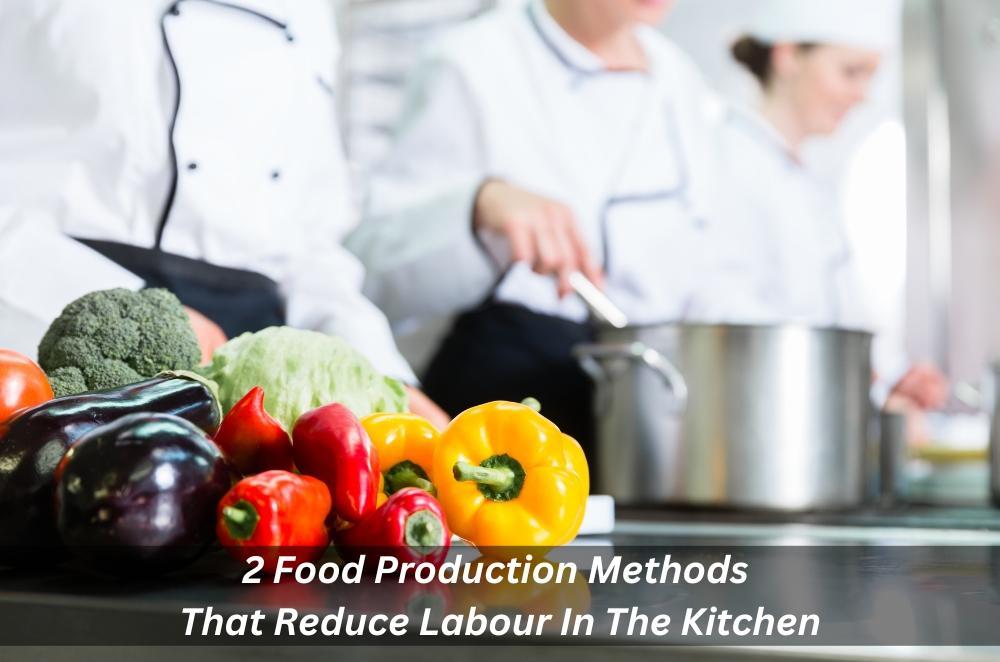2 Food Production Methods That Reduce Labour In The Kitchen

How do food production trends help restaurant owners in managing their labour and food costs? Are you spending too much of your day in the kitchen? Food preparation can be time-consuming and laborious, but there are several new methods that can reduce the amount of effort required.
Kitchen labour is an expensive and burdensome aspect of managing a business Chefs, cooks, and other workers need to prepare meals quickly while maintaining quality standards. Restaurant management may even hire additional full-time employees at an hourly rate to help with food preparation and cooking
Fortunately, technology is offering restaurateurs new solutions for food production.Two relatively new methods - the sous vide method and robotic manufacturing - are becoming popular for greatly reducing labour costs in the kitchen. In this article, let’s take a look at how these two methods work and how they could impact culinary operations today
Sous Vide Method: Overview andAdvantages
Sous vide is a French term meaning “under vacuum ”This method of cooking involves placing food items in a sealed plastic bag and then submerging it in a water bath at a precise temperature for an extended time period The temperature is monitored to ensure that the food is cooked evenly and consistently Advantages of sous vide include improved flavour, tenderness, and texture Food retains more moisture than traditional cooking methods, resulting in juicier dishes It also eliminates the need to continually monitor the food while it cooks, which saves time and labour costs. In addition, because the food cooks slowly over low heat, there’s less chance of overcooking
Robotic Manufacturing: What It Is & Its Benefits
Robotic manufacturing is a method of using machines to automate food production This technology uses robots to prepare, package, and release meals with repeatable accuracy and efficiency Robotic manufacturing can significantly reduce labour costs in the kitchen by automating repetitive tasks such as chopping, slicing, and dicing.The machines are also capable of performing more complex tasks such as assembling sandwiches or plating dishes.
Advantages of robotic manufacturing include improved consistency, reduced food waste, and fewer errors. Since the robots are programmed to follow exact instructions each amount of time, there’s less chance of mistakes being made in the preparation process In addition, robotic manufacturing can be used to produce a larger amount of food in less time than manual labour
Comparisons Between Sous Vide & Robotic Manufacturing for Food Production
Both sous vide and robotic manufacturing offer advantages for reducing labour costs in the kitchen However, it’s important to note that they are not interchangeable methods of food production The sous vide method is best suited for slow-cooking applications such as steaks, poultry, and fish; while robotic manufacturing is better suited for faster-paced tasks such as chopping vegetables or assembling sandwiches
Both methods have their own set of benefits and drawbacks. For instance, sous vide requires more upfront investment since you need to purchase a water bath machine and special vacuum-sealed bags; whereas robotic manufacturing requires a larger initial investment due to the cost of the robots.
Strategies for IncorporatingAutomated Food Production in the Kitchen
When incorporating automated food production methods into your kitchen, it’s important to consider your current food processing and workflow If you have a large projected sales volume of orders, robotic manufacturing is probably the best option since it can handle most tasks with speed and efficiency However, if you specialize in slow-cooked dishes such as steaks or poultry, then sous vide may be the better choice due to its ability to cook at precise temperatures.
National food service industry standards should also be taken into account when incorporating automated food production.This includes making sure that the machines meet safety and hygiene standards, as well as ensuring that they are capable of producing food that meets quality control guidelines
Whichever method you choose, it’s important to make sure that you have a plan for integrating automated food production into your existing food service operation This includes training full-time or part-time employees on how to operate and maintain the machines, as well as ensuring that the machines are compatible with your existing food safety kitchen equipment

